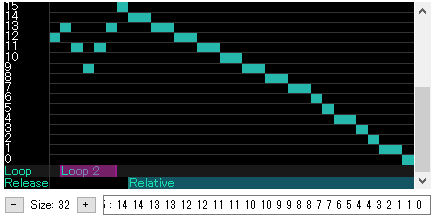-
Notifications
You must be signed in to change notification settings - Fork 28
Instrument Editor
In BambooTracker, there is a corresponding instrument editor for each instrument.
The detailed explanation for each editor is left to each item, and here we will explain the common parts of each instrument editor.
Instruments have editing factors called properties, such as envelopes, arpeggios, and pitches. You can change the tone by editing these properties.
The property number (left side of the figure) and property user (right side) are displayed at the top of each property group.
Properties are common within a module, and multiple instruments can share the same property. When you change a property, the properties of the instrument that shares that property are also changed.
Which instruments are sharing properties is shown to Users.
The number displayed is the instrument number registered in the instrument list.

Some properties can specify changing parameters per tick. This series of parameter changes is called a sequence, and the sequence editor is used to edit the sequence.

The parameter value corresponding to that column is displayed at the left end of the editor. Sequence values are set by left-clicking or dragging.
The length of the sequence can be changed with the "+" "-" button at the bottom left of the editor.
You can loop the execution of part of a sequence.
Left-click anywhere on the Loop line at the bottom of the editor to create a loop.
You can move the start and end points of the loop by dragging both ends of the loop.
You can also change the number of loops by clicking in the loop section.
The number of loops increases with a left click and decreases with a right click.
The number of loops is indicated by the number after the "Loop" character in the loop.
Note that loops for which the loop count is not displayed are infinite loops.
You can set the execution from the time when note-off is executed on the track to which the instrument is set as a sequence.
Left-click on the Release line at the bottom of the editor to set the release point.
At note-off time, the sequence is executed from this release point.
You can release a release by right clicking on it.
At the bottom right of the sequence editor is the sequence text editor. Here you can set the text sequence.
Sequence parameters are indicated by line numbers, and ticks are separated by spaces.
Surround the loop with [ and ]. The number of loops can be specified immediately after ].
Release settings can be specified by hitting the release point at the start of the release. The normal release is specified with |.
In text editors that enter numbers, slope notation is available.
In slope notation, you can specify a linear change by specifying start_end or start_end_difference.
The sequence is expanded as follows in the slope notation.
| Slope notation | Converted |
|---|---|
0_5 |
0 1 2 3 4 5 |
15_10 |
15 14 13 12 11 10 |
4_12_3 |
4 7 10 12 |
6_1_-2 |
6 4 2 1 |